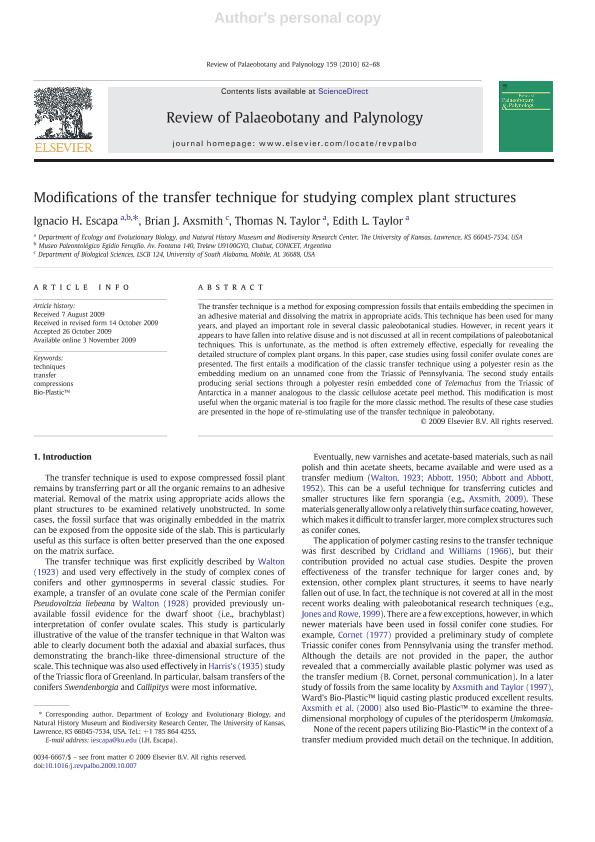Mostrar el registro sencillo del ítem
dc.contributor.author
Escapa, Ignacio Hernán

dc.contributor.author
Axsmith, Brian J.
dc.contributor.author
Taylor, Thomas N.
dc.contributor.author
Taylor, Edith L.
dc.date.available
2018-10-17T15:42:41Z
dc.date.issued
2010-02
dc.identifier.citation
Escapa, Ignacio Hernán; Axsmith, Brian J.; Taylor, Thomas N.; Taylor, Edith L.; Modifications of the transfer technique for studying complex plant structures; Elsevier Science; Review of Palaeobotany and Palynology; 159; 1-2; 2-2010; 62-68
dc.identifier.issn
0034-6667
dc.identifier.uri
http://hdl.handle.net/11336/62548
dc.description.abstract
The transfer technique is a method for exposing compression fossils that entails embedding the specimen in an adhesive material and dissolving the matrix in appropriate acids. This technique has been used for many years, and played an important role in several classic paleobotanical studies. However, in recent years it appears to have fallen into relative disuse and is not discussed at all in recent compilations of paleobotanical techniques. This is unfortunate, as the method is often extremely effective, especially for revealing the detailed structure of complex plant organs. In this paper, case studies using fossil conifer ovulate cones are presented. The first entails a modification of the classic transfer technique using a polyester resin as the embedding medium on an unnamed cone from the Triassic of Pennsylvania. The second study entails producing serial sections through a polyester resin embedded cone of Telemachus from the Triassic of Antarctica in a manner analogous to the classic cellulose acetate peel method. This modification is most useful when the organic material is too fragile for the more classic method. The results of these case studies are presented in the hope of re-stimulating use of the transfer technique in paleobotany. © 2009 Elsevier B.V. All rights reserved.
dc.format
application/pdf
dc.language.iso
eng
dc.publisher
Elsevier Science

dc.rights
info:eu-repo/semantics/openAccess
dc.rights.uri
https://creativecommons.org/licenses/by-nc-sa/2.5/ar/
dc.subject
Bio-Plastic&Trade;
dc.subject
Compressions
dc.subject
Techniques
dc.subject
Transfer
dc.subject.classification
Meteorología y Ciencias Atmosféricas

dc.subject.classification
Ciencias de la Tierra y relacionadas con el Medio Ambiente

dc.subject.classification
CIENCIAS NATURALES Y EXACTAS

dc.title
Modifications of the transfer technique for studying complex plant structures
dc.type
info:eu-repo/semantics/article
dc.type
info:ar-repo/semantics/artículo
dc.type
info:eu-repo/semantics/publishedVersion
dc.date.updated
2018-10-12T18:05:30Z
dc.journal.volume
159
dc.journal.number
1-2
dc.journal.pagination
62-68
dc.journal.pais
Países Bajos

dc.journal.ciudad
Amsterdam
dc.description.fil
Fil: Escapa, Ignacio Hernán. Consejo Nacional de Investigaciones Científicas y Técnicas; Argentina. Museo Paleontológico Egidio Feruglio; Argentina. University of Kansas; Estados Unidos
dc.description.fil
Fil: Axsmith, Brian J.. University of South Alabama; Estados Unidos
dc.description.fil
Fil: Taylor, Thomas N.. University of Kansas; Estados Unidos
dc.description.fil
Fil: Taylor, Edith L.. University of Kansas; Estados Unidos
dc.journal.title
Review of Palaeobotany and Palynology

dc.relation.alternativeid
info:eu-repo/semantics/altIdentifier/url/https://www.sciencedirect.com/science/article/pii/S0034666709002024
dc.relation.alternativeid
info:eu-repo/semantics/altIdentifier/doi/https://dx.doi.org/10.1016/j.revpalbo.2009.10.007
Archivos asociados
